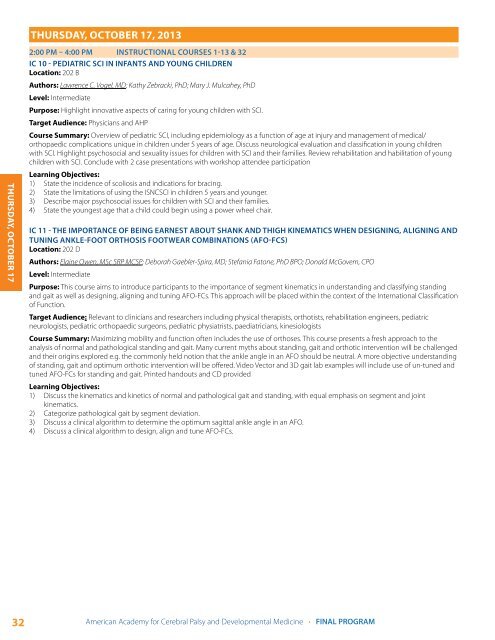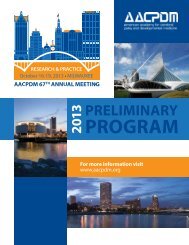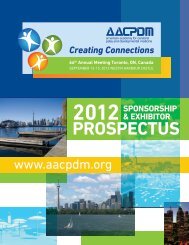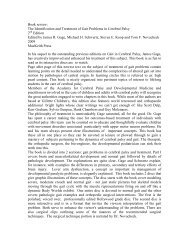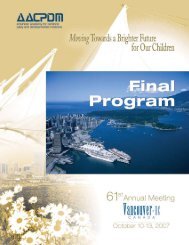Thursday, October 17, 2013THURsday, October 172:00 pm – 4:00 pm Instructional Courses 1-13 & 32IC 10 - PEDIATRIC SCI IN INFANTS AND YOUNG CHILDRENLocation: 202 BAuthors: Lawrence C. Vogel, MD; Kathy Zebracki, PhD; Mary J. Mulcahey, PhDLevel: IntermediatePurpose: Highlight innovative aspects of caring <strong>for</strong> young children with SCI.Target Audience: Physicians <strong>and</strong> AHPCourse Summary: Overview of pediatric SCI, including epidemiology as a function of age at injury <strong>and</strong> management of medical/orthopaedic complications unique in children under 5 years of age. Discuss neurological evaluation <strong>and</strong> classification in young childrenwith SCI. Highlight psychosocial <strong>and</strong> sexuality issues <strong>for</strong> children with SCI <strong>and</strong> their families. Review rehabilitation <strong>and</strong> habilitation of youngchildren with SCI. Conclude with 2 case presentations with workshop attendee participationLearning Objectives:1) State the incidence of scoliosis <strong>and</strong> indications <strong>for</strong> bracing.2) State the limitations of using the ISNCSCI in children 5 years <strong>and</strong> younger.3) Describe major psychosocial issues <strong>for</strong> children with SCI <strong>and</strong> their families.4) State the youngest age that a child could begin using a power wheel chair.IC 11 - THE IMPORTANCE OF BEING EARNEST ABOUT SHANK AND THIGH KINEMATICS WHEN DESIGNING, ALIGNING ANDTUNING ANKLE-FOOT ORTHOSIS FOOTWEAR COMBINATIONS (AFO-FCS)Location: 202 DAuthors: Elaine Owen, MSc SRP MCSP; Deborah Gaebler-Spira, MD; Stefania Fatone, PhD BPO; Donald McGovern, CPOLevel: IntermediatePurpose: This course aims to introduce participants to the importance of segment kinematics in underst<strong>and</strong>ing <strong>and</strong> classifying st<strong>and</strong>ing<strong>and</strong> gait as well as designing, aligning <strong>and</strong> tuning AFO-FCs. This approach will be placed within the context of the International Classificationof Function.Target Audience: Relevant to clinicians <strong>and</strong> researchers including physical therapists, orthotists, rehabilitation engineers, pediatricneurologists, pediatric orthopaedic surgeons, pediatric physiatrists, paediatricians, kinesiologistsCourse Summary: Maximizing mobility <strong>and</strong> function often includes the use of orthoses. This course presents a fresh approach to theanalysis of normal <strong>and</strong> pathological st<strong>and</strong>ing <strong>and</strong> gait. Many current myths about st<strong>and</strong>ing, gait <strong>and</strong> orthotic intervention will be challenged<strong>and</strong> their origins explored e.g. the commonly held notion that the ankle angle in an AFO should be neutral. A more objective underst<strong>and</strong>ingof st<strong>and</strong>ing, gait <strong>and</strong> optimum orthotic intervention will be offered. Video Vector <strong>and</strong> 3D gait lab examples will include use of un-tuned <strong>and</strong>tuned AFO-FCs <strong>for</strong> st<strong>and</strong>ing <strong>and</strong> gait. Printed h<strong>and</strong>outs <strong>and</strong> CD providedLearning Objectives:1) Discuss the kinematics <strong>and</strong> kinetics of normal <strong>and</strong> pathological gait <strong>and</strong> st<strong>and</strong>ing, with equal emphasis on segment <strong>and</strong> jointkinematics.2) Categorize pathological gait by segment deviation.3) Discuss a clinical algorithm to determine the optimum sagittal ankle angle in an AFO.4) Discuss a clinical algorithm to design, align <strong>and</strong> tune AFO-FCs.32<strong>American</strong> <strong>Academy</strong> <strong>for</strong> <strong>Cerebral</strong> <strong>Palsy</strong> <strong>and</strong> Developmental Medicine • FINAL PROGRAM
Thursday, October 17, 20132:00 pm – 4:00 pm Instructional Courses 1-13 & 32IC 12 - DIAGNOSTIC APPROACH TO THE ATAXIC CHILDLocation: 201 AAuthors: Andrea Poretti, MD; Hilary Gwynn, MD; Alec Hoon, MDLevel: IntermediatePurpose: To provide a diagnostic approach to the ataxic child based on clinical history, neurological examination, <strong>and</strong> in depthidentification of the clinical manifestation of motor, cognitive, <strong>and</strong> additional investigations.Target Audience: Clinicians involved in the diagnostic evaluation of children with ataxia.Course Summary: Ataxia comes from the Greek <strong>and</strong> means “lack of order”. In medicine, ataxia refers to impaired ability to coordinatemuscle activity in the execution of voluntary movements. An unsteady, broad-based gait is the main clinical manifestation of ataxia.Additional clinical findings may be present depending on the etiology of ataxia. Generally, lesions affecting 3 main systems may causeataxia: cerebellum, sensory <strong>and</strong> vestibular system. Additionally, ataxia may be functional or psychogenic. According to the amount of timeover which symptoms present <strong>and</strong> evolve, different <strong>for</strong>ms of ataxia have been defined: non-progressive, progressive, acute, episodic, <strong>and</strong>intermittent. Based on selected, illustrative clinical situations, we will discuss how clinical history, neurological examination <strong>and</strong> additionalinvestigations (e.g. neuroimaging, electrophysiology, laboratory investigations) may help to differentiate between the different <strong>for</strong>ms ofataxia in children.Learning Objectives:1) The participant will identify the different systems that, if affected, may cause ataxia.2) The participant will recognize the role of clinical history <strong>and</strong> neurological examination in differentiating pediatric ataxia secondary tocerebellar, sensory, <strong>and</strong> vestibular lesions <strong>and</strong> functional ataxia.3) The participant will recognize the targeted indication of additional investigations in pediatric ataxia.4) The participant will identify common etiologies of the different ataxia types in children.IC 13 - ADVANCES IN THE NEUROPSYCHOLOGY OF CEREBRAL PALSYLocation: 202 CAuthors: Seth A. Warschausky, PhD; Jacqueline Kaufman, PhD; Heidi Haapala, MDLevel: IntermediatePurpose: To improve clinicians’ underst<strong>and</strong>ing of attention, executive function, visuospatial <strong>and</strong> other neuropsychological risks associatedwith CP including brain-behavior relations that underlie cognitive impairments. To describe neuropsychological applications to medicalpractice including monitoring iatrogenic effects, examining treatment outcomes, <strong>and</strong> <strong>for</strong>mulating school recommendations.Target Audience: This course is designed <strong>for</strong> physicians, therapists <strong>and</strong> educators who treat children with CP, <strong>and</strong> researchers who examinecognitive factors.Course Summary: Faculty from the University of Michigan’s Adapted Cognitive Assessment Laboratory (ACAL) illustrate key concepts in theneuropsychology of CP with findings from the NIH <strong>and</strong> DOED/NIDRR funded studies of 170 children with CP. An overview of cutting edgeunderst<strong>and</strong>ings of the neuropsychology of CP incorporates these findings. Practice guidelines <strong>and</strong> empirically grounded applications toclinical practice are described.Learning Objectives:1) To review the nature of neuropsychological assessment <strong>and</strong> new developments in accessible tests of cognitive functions.2) To refine knowledge of specific neuropsychological risks associated with CP.3) To refine underst<strong>and</strong>ing of the neuropathology associated with specific neuropsychological risks.4) To develop an underst<strong>and</strong>ing of the important clinical applications of neuropsychological assessment of children with CP.THURsday, October 17AACPDM 67 th Annual Meeting • Research & Practice 33
- Page 1 and 2: 2013 FINALProgramFor more informati
- Page 3 and 4: 2012-2013 BOARD OF DIRECTORSPreside
- Page 5 and 6: Meeting at a GlanceFRIDAY, OCTOBER
- Page 7 and 8: 67th Annual MeetingOctober 16-19, 2
- Page 9 and 10: AACPDM 67 th Annual Meeting2013 Mob
- Page 11 and 12: General Meeting InformationTicketed
- Page 13 and 14: Membership BenefitsHow can you bene
- Page 15 and 16: Invited LecturersStrategic Research
- Page 17 and 18: Grants and ScholarshipsAACPDM Resea
- Page 19 and 20: Wednesday, October 16: Pre-Conferen
- Page 21 and 22: Wednesday, October 16: Pre-Conferen
- Page 23 and 24: Thursday, October 17, 20137:00 am-7
- Page 25 and 26: Thursday, October 17, 20138:00 am-1
- Page 27 and 28: Thursday, October 17, 201310:45am -
- Page 29: Thursday, October 17, 20132:00 pm -
- Page 34 and 35: Thursday, October 17, 2013THURsday,
- Page 36 and 37: Friday, October 18, 20136:00 am-6:4
- Page 38 and 39: Friday, October 18, 20137:00 am-7:5
- Page 40 and 41: Friday, October 18, 201310:30 am-12
- Page 42 and 43: Friday, October 18, 201312:30 pm -
- Page 44 and 45: Friday, October 18, 20134:00 pm - 6
- Page 46 and 47: Friday, October 18, 20134:00 pm - 6
- Page 48 and 49: Friday, October 18, 20134:00 pm - 6
- Page 50 and 51: Saturday, October 19, 20137:00 am-7
- Page 52 and 53: Saturday, October 19, 20138:00 am-1
- Page 54 and 55: Saturday, October 19, 201310:15 am-
- Page 56 and 57: Saturday, October 19, 20131:30 pm-3
- Page 58 and 59: Saturday, October 19, 20131:30 pm-3
- Page 60: Saturday, October 19, 20131:30 pm-3
- Page 63 and 64: Scientific PostersSP1 - REDUCTION I
- Page 65 and 66: Scientific PostersSP38 - IMPACT OF
- Page 67 and 68: Demonstration PostersDP1 - TRACKING
- Page 69 and 70: AACPDM Past and Future Presidents19
- Page 71 and 72: Exhibiting and Sponsoring Organizia
- Page 73 and 74: Exhibiting and Sponsoring Organizia
- Page 75 and 76: Disclosure IndexA=Research and inst
- Page 77 and 78: Disclosure IndexG9 Park, M (F) Chun
- Page 79 and 80: Disclosure IndexInvited SpeakersBac
- Page 81 and 82: Author IndexChan, Jeremy ..........
- Page 83 and 84:
Author IndexGutman, Karli .........
- Page 85 and 86:
Author IndexMatsumoto, Hiroko. ....
- Page 87 and 88:
Author IndexSSaavedra, Sandra .....
- Page 89:
Author IndexWingate, Martha .......


